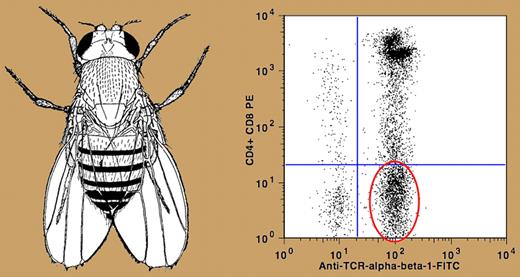In this issue of Blood, Teachey and colleagues illustrate the lympholytic potential of targeted Notch signal inhibition by using a low potency γ-secretase inhibitor (GSI) on an extended use schedule of 5mg/kg/day over 6 to12 weeks in 2 strains of Fas-deficient (CBA/lpr−/− and MRL/lpr −/−) murine models of lymphoproliferation and autoimmune disease. First described in 1917 by Thomas Hunt Morgan (for whom the centimorgan unit of measure of genetic linkage is named), the notched-wing phenotype of Drosophila melanogaster with thickening of the wing vein is a sex-linked recessive loss-of-function mutation. It is associated with the evolutionarily conserved eponymous protein Notch that plays a pleiotropic role during cellular ontogeny and epigenetic silencing by regulating angiogenesis, myogenesis, neurogenesis, and gliogenesis. Recent studies have elucidated the role of Notch transcriptional networks as germane to T-cell development, activation, and differentiation signaling.1
Historically, studies in Fas-deficient MRL/lpr−/− mice, which develop massive lymphadenopathy, hepatosplenomegaly, autoimmune nephropathy, and expansion of double-negative (DN) T lymphocytes, have provided insights into the seminal role of Fas and apoptosis in lymphocyte homeostasis and the pathophysiology of a similar syndrome in humans.2 Subsequently named autoimmune lymphoproliferative syndrome (ALPS), this disorder is most often associated with heterozygous mutations in the gene encoding the Fas protein inherited as an autosomal dominant trait with variable penetrance. ALPS has a distinct clinical phenotype. This results from an accumulation of lymphocytes due to impaired apoptosis and leads to childhood onset chronic lymphadenopathy, hepatosplenomegaly, multilineage cytopenias secondary to sequestration and autoimmune destruction, and an increased risk of B-cell lymphoma. While the vast majority of the approximately 400 ALPS patients studied worldwide over the past 15 years have a self-limiting course, a subset have severe disease and require treatment for cytopenias. They often respond to conventional immunosuppressive regimens consisting of corticosteroids and/or alternative steroid-sparing medications.3
Left panel: The notched-wing phenotype of Drosophila melanogaster with thickening of the wing vein, which is a sex-linked recessive trait with a loss of function mutation. Reproduced from Thomas H. Morgan. “The theory of the gene.” The American Naturalist (609):513-544.1917. weblink < http://www.esp.org/books/morgan/theory/facsimile/contents.htm > . Right panel: Flow cytometry showing excess of double negative (TCR αβ + /CD4-/CD8-) T lymphocytes comprising 21% (9985 cells) of the peripheral blood mononuclear cells in a patient with profound lymphoproliferation due to ALPS. (Flow cytometry figure courtesy of Margaret Brown, NIH)
Left panel: The notched-wing phenotype of Drosophila melanogaster with thickening of the wing vein, which is a sex-linked recessive trait with a loss of function mutation. Reproduced from Thomas H. Morgan. “The theory of the gene.” The American Naturalist (609):513-544.1917. weblink < http://www.esp.org/books/morgan/theory/facsimile/contents.htm > . Right panel: Flow cytometry showing excess of double negative (TCR αβ + /CD4-/CD8-) T lymphocytes comprising 21% (9985 cells) of the peripheral blood mononuclear cells in a patient with profound lymphoproliferation due to ALPS. (Flow cytometry figure courtesy of Margaret Brown, NIH)
Teachey et al show that inhibition of the γ secretase substrate, Notch, by N-[N-(3,5-difluorophenacetyl)-L-alanyl]-S-phenyl glycine t-butyl ester (DAPT) was effective in reversing the apoptosis defect resulting in decreased lymphadenopathy, splenomegaly, and autoantibodies in Fas-deficient lpr−/− mice with a pronounced reduction of DNT cells. The only side effect noted was neutropenia, although other studies using GSI compounds have found additional toxicities including thymic atrophy and intestinal epithelial defects. Further preclinical studies addressing the safety profiles of the secretase inhibitors are warranted and underway.4 Treatment of children with ALPS, chronic ITP, and other nonmalignant autoimmune diseases such as SLE require prolonged courses of therapy; thus a large margin of safety between the therapeutic dose and a dose causing serious side effects is necessary.5 Nevertheless, it is heartening to observe that familiar compounds with acceptable side effect profiles are undergoing a renaissance with the discovery that they also work through cross talk between pathways affecting Notch, acetylated histones, lysosomes and demethylating agents.6 Only a select group of children and young adults with significant morbidity due to autoimmune and/or nonmalignant, polyclonal lymphoproliferative processes may require cytotoxic therapies that attempt to cytoreduce their lymph nodes and spleen. Careful patient selection and thoughtful clinical trial design will be required to take full advantage of agents designed to interrupt Notch signaling in patients with ALPS.
Conflict-of-interest disclosure: The author declares no competing financial interests. ■


This feature is available to Subscribers Only
Sign In or Create an Account Close Modal